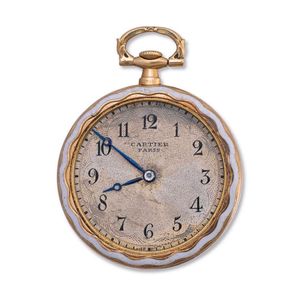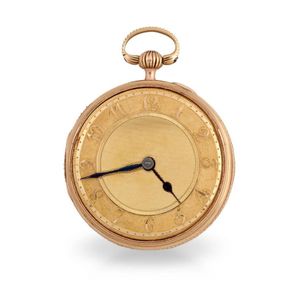George III Gold Pocket Watch, 1807
You must be a subscriber, and be logged in to view price and dealer details.
Subscribe Now to view actual auction price for this item
When you subscribe, you have the option of setting the currency in which to display prices to $Au, $US, $NZ or Stg.
- George Iii - George III (1738 - 1820) was King of Great Britain and Ireland from 1760 to 1820.
- Engine Turned - Engine turning is a decorative technique used on metal surfaces to create intricate curving or geometric pattern. The process involves cutting a series of lines into the surface of the metal using a rose engine or decoration lathe which rotates the metal as it cuts, allowing the operator to create a repeating pattern that covers the entire surface. The resulting surface has a shimmering, reflective quality that is often described as "engine turned." Where an engine turned item has been enamelled, the term used to describe the decoration is usually guilloche.
Engine turning was originally developed to decorate metal objects such as firearms, scientific instruments, and other metal objects that required precise and elegant design. - Movement - The technical name for the workings of a clock or watch, and does not include the dial or case.
- Fusee - The fusee movement was used in clocks and pocket watches from the mid 17th century. The fusee is a cone shaped drum within the works that is linked to the barrel of the spring, usually by a length of chain.
As the mainspring loses its tension over time, the cone shaped barrel compensates for this by increasing the tension, by pulling the mainspring tighter, thus ensuring the time remains constant.
Use of the fusee in clocks was superseded by the "going barrel" in the mid 19th century and for pocket watches at the beginning of the 19th century.
The fusee continued to be used in marine chronometers until the 1970s.
This item has been included into following indexes:
Visually similar items

A good mid Victorian 'Dent' consular case open face pocket watch, engraved gold face with engine turned chapter ring and Roman numerals. Hallmarked Chester 1855. 18ct gold. Signed lever fusee and chain movement N.20105. Diameter 47 mm.

A lady's gold, enamel and diamond-set openface keyless lever watch Cartier, no.1307, circa 1920 gilt-finished jewelled lever movement, silvered matt dial, Arabic numerals, blued steel moon-style hands, white enamel wave pattern bezel, in circular ultra thi

An early 19th century Swiss open face pocket watch, c.1830, full plate with oval pierced cock plate, verge with fusee and chain drive movement. Breguet silver dial and hands. Diameter 41 mm. TW 48gms.

David Morice An 18ct gold open-faced pocketwatch mvt 4429 English circa 1840, english fusee cylinder movement signed and numbered David Morice, Fenchurch Street no. 4429, cylindrical pillars, diamond endstone, gold engine-turned dial, Arabic numerals, blue
